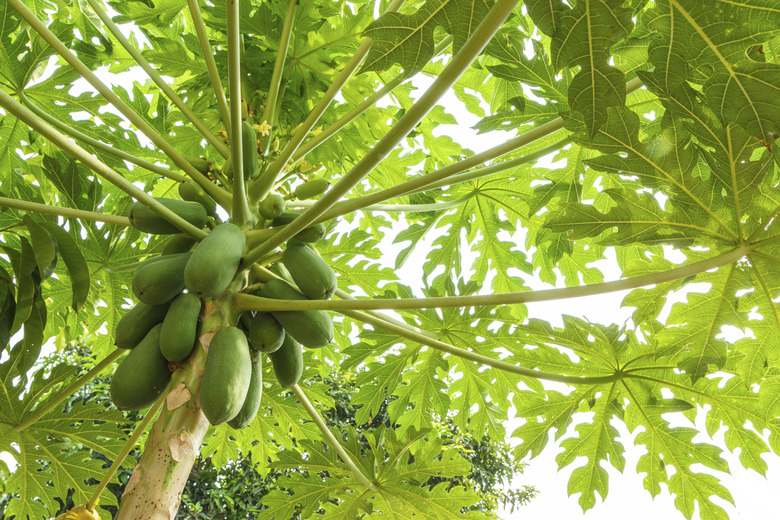How Long Does It Take For A Papaya Tree To Produce Fruit?
Most healthy, established papaya trees (Carica papaya) bear fruit seven to 11 months after planting. Their fruiting is influenced by a number of factors and may be delayed or prevented entirely depending on the plant and its environment. Papaya trees grow the warm climates of in U.S. Department of Agriculture plant hardiness zones 10 to 12.
Sex and Flower Type
Sex and Flower Type
Papayas express three different sexual forms: hermaphroditic, female and male. Female and hermaphroditic papayas are capable of bearing fruit, while male plants cannot. The flowers indicate which sex the plant is, although the differences are often subtle. Female flowers have a large, conical bud with a swollen ovary at the base, while hermaphroditic flowers have a more cylindrical bud with a smaller ovary and stamens inside. Male buds are slender and have no ovary at the base. Hermaphroditic flowers are self-pollinating because they contain both male and female parts, while female plants require a male to pollinate them. Planting more than three papayas will increase the odds of getting a self-pollinating hermaphrodite or a mix of female and male plants.
Encouraging Fruits
Encouraging Fruits
To bear fruit, papaya trees need warm weather, full sun and moist, loamy soil. Temperatures below 59 degrees Fahrenheit inhibit blooming and can result in deformed fruit. Temperatures above 90 F can cause blossom drop and, when combined with drought, can reverse the sex of the plant from female or hermaphroditic to male, which will prevent fruiting. Keep papaya trees watered and allow the soil to dry out on the surface between waterings. Keep overhanging trees pruned back so the papaya tree isn't shaded. In marginal areas below USDA zone 10b, grow papayas in a pot so they can be brought indoors in temperature extremes.
Poor Pollination
Poor Pollination
Female papaya trees need pollinators and a nearby male tree to produce fruit. A lack of male plants or insect pollinators may prevent or delay a papaya's first fruiting, which will shorten its useful life in the garden. Once you've got both male and female trees, you may need to increase their attractiveness to butterflies, bees and other pollinators. Surround papayas with insect-friendly plants that share similar growing conditions such as the blue passionflower (Passiflora caerulea) and golden dewdrop (Duranta erecta), both of which grow in USDA zones 8 through 11. Also, plant papayas no more than 20 feet apart so the wind can carry pollen between them.
Transplant Shock
Transplant Shock
Young papaya trees do not transplant well and may enter shock if their planting conditions are not ideal. Transplant shock can cause serious issues with young papayas, including branch dieback and delayed fruiting. To decrease the likelihood of damage, plant papayas in fall when the weather is mild and moist and cover the root zone with mulch to keep the soil warm. Handle the root ball gently during the transplant process to avoid damaging the roots, and position the top of the root ball slightly above the soil's surface so excess moisture will drain away.
References
- Missouri Botanical Garden: Carica Papaya
- University of Florida IFAS Extension: Papaya Growing in the Florida Home Landscape
- Logee's Plants for Home and Garden: Cultural Information–Papaya
- University of Hawaii at Manoa College of Tropical Agriculture and Human Resources: Why Some Papaya Plans Fail to Fruit
- St. Lucie Master Gardeners: Nectar Gardening for Butterflies, Honey Bees and Native Bees
- Floridata: Passiflora Caerulea
- Floridata: Duranta Erecta
- California Rare Fruit Growers: Papaya Fruit Facts
